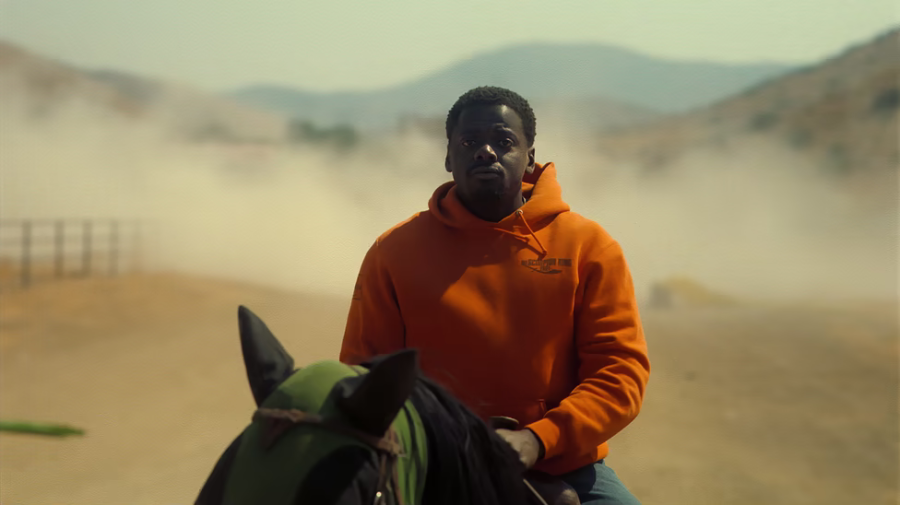Jordan Peele’s ‘Nope’ Makes You Look Up
August 5, 2022
“The Horse in Motion”
In 1873, the billionaire industrialist Leland Stanford, founder of Stanford University, approached photographer Eadweard Muybridge to photograph his horses. Stanford hoped that the camera would be able to illustrate the position of a horse’s limbs when it was in motion and tell whether all four hooves ever leave the ground. At the time, this was something that was unproven and hotly debated among racers.
After several false starts, Muybridge was able to capture a series of photos of a horse being ridden by a jockey around Stanford’s race track, running at full speed. Later, Muybridge had the photos traced onto a glass disc. Using a device called the Zoöpraxiscope, which he invented, Muybridge was able to project a moving, looping gif-like image of the horse running. “The Horse in Motion” became one of the first examples of what we call motion pictures.
In “Nope,“ Jordan Peele‘s third movie, this piece of film history is given thematic resonance. “Nope” is a movie about looking. It’s about watching movies just as much as it is about aliens. In the beginning, Emerald Haywood, played by the ineffable and vibrant Keke Palmer, relates the story of “The Horse in Motion” to a disinterested film crew. Emerald’s older brother O.J. (Daniel Kaluuya) took over their family business, training and wrangling horses for movies after their dad (Keith David) died in a freak accident. Their great-great-great grandfather, Alistair Haywood, was the unacknowledged jockey in the Muybridge-Stanford photos, and so, as Emerald explains, “since the moment pictures could move we had skin the game.”
After leaving the film set O.J. and Emerald stop by Jupiter’s Claim, a tourist trap theme park run by former child star Ricky Park (Steven Yeun). Ricky offers to buy one of the Haywood’s horses to use in his show and to subsequently relieve some of their financial burdens. This offer becomes either a blessing or a curse when something in the sky over the Haywood’s desert ranch starts to make the horses disappear. Emerald and O.J. quickly come to the conclusion that the best course of action would be to capture the UFO on video, proving the existence of extraterrestrials and making a buttload of money.
Earns Surprises, Doesn’t Try to Outsmart the Audience
There is never any question that there is an alien in the sky above California. “Nope” doesn’t try to obscure what it’s about, or outsmart the audience. The surprises, which come fast and hard, are earned and satisfying. The exhilaration of “Nope” comes from watching the characters react to the phenomena. This thriller is all the more effective because one comes to care deeply about the fate and wellbeing of O.J., Emerald and the Haywood Ranch. Kaluuya and Palmer keep the audience’s feet on the ground amid the spectacle with commanding performances.
One could just enjoy “Nope” on the surface level as a piece of entertaining spectacle, and not be wrong to do so. However, for those willing to dig a bit deeper, there is something much more rich and complex going on. “Nope” is about looking. All different sorts of looking. What do you do when you pass a car accident? You look. What do you do when you hear about an awful, gruesome murder or a freak accident? You look it up on your phone. What are you doing while sitting in a movie theater watching “Nope”? You look.
What does it mean to keep looking at tragedies? What does it mean that we’re entertained by movies made in an industry built on the exploitation and abuse of children and animals? An industry that erases the contributions of people of color, such as the jockey in “The Horse in Motion”?
While these questions are not necessarily answered forthright, they stick with the viewer after the credits roll. “Nope” stays with you for days on end, constantly nagging attention in your mind.
Peele Does Spielberg
Above all, “Nope” is a first-rate piece of popcorn entertainment. It’s as full of cinematic exhilaration and awe at the unknown as anything made by Steven Spielberg. When other filmmakers have paid homage to Spielberg, in movies such as “Super 8,” or TV Shows like “Stranger Things,” they focus on the whimsy and nostalgia. Peele instead understands the sense of adrenaline-pumping adventure that one feels when watching “Jaws” or “Raiders of the Lost Ark,” and is able to bring that rousing cinematic experience to “Nope.”
“Nope” is as scary as anything, but a nice, fun kind of scary, like a roller-coaster. It’s thrilling, ambitious, imaginative and cleverly plotted. It’s the sort of movie to make you pump your fist in the air, yell at the screen and forget about the outside world.








